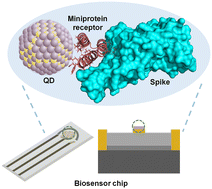A miniprotein receptor electrochemical biosensor chip based on quantum dots†
Abstract
Recently protein binders have emerged as a promising substitute for antibodies due to their high specificity and low cost. Herein, we demonstrate an electrochemical biosensor chip through the electronic labelling strategy using lead sulfide (PbS) colloidal quantum dots (CQDs) and the unnatural SARS-CoV-2 spike miniprotein receptor LCB. The unnatural receptor can be utilized as a molecular probe for the construction of CQD-based electrochemical biosensor chips, through which the specific binding of LCB and the spike protein is transduced to sensor electrical signals. The biosensor exhibits a good linear response in the concentration range of 10 pg mL−1 to 1 μg mL−1 (13.94 fM to 1.394 nM) with the limit of detection (LOD) being 3.31 pg mL−1 (4.607 fM for the three-electrode system) and 9.58 fg mL−1 (0.013 fM for the HEMT device). Due to the high sensitivity of the electrochemical biosensor, it was also used to study the binding kinetics between the unnatural receptor LCB and spike protein, which has achieved comparable results as those obtained with commercial equipment. To the best of our knowledge, this is the first example of using a computationally designed miniprotein receptor based on electrochemical methods, and it is the first kinetic assay performed with an electrochemical assay alone. The miniprotein receptor electrochemical biosensor based on QDs is desirable for fabricating high-throughput, large-area, wafer-scale biochips.



 Please wait while we load your content...
Please wait while we load your content...